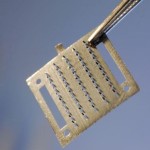
A vaccine delivered to the skin using a microneedle patch gives better protection against the H1N1 influenza virus than a vaccine delivered through subcutaneous or intramuscular injection, researchers from Emory University and Georgia Institute of Technology have found.
Mice given a single H1N1 vaccine through the skin using a coated metal microneedle patch as well as mice vaccinated through subcutaneous injection were 100 percent protected against a lethal flu virus challenge six weeks after vaccination. When challenged with the H1N1 virus six months later, the injected mice had a 60 percent decrease in antibody production against the virus and extensive lung inflammation. Mice that were vaccinated with microneedles, on the other hand, maintained high levels of protection and antibody production after six months, with no signs of lung inflammation.
“A major goal of influenza vaccine development has been to confer strong immune responses, including immunological memory and cellular immune responses for long-term protection, and to limit virus spread after infection,” says first author Dimitrios Koutsonanos, MD, post-doctoral fellow of microbiology and immunology at Emory University School of Medicine.
Researchers already have found that intramuscular injection is not the most efficient way to deliver vaccines. The muscles have a low concentration of cells needed to relay immune signals and activate a T-cell response, including dendritic cells, macrophages, and MHC class II-expressing cells. The skin, however, contains a rich network of antigen-presenting cells, including macrophages, Langerhans cells and dermal dendritic cells that activate cytokines and chemokines – immune signaling cells responsible for initiating an immune response.
The joint research team previously reported that delivery of seasonal influenza vaccine through the skin using antigen-coated metal microneedle patches or dissolving microneedles elicited strong immune responses that can confer protection at least equal to conventional intramuscular injections. The team has developed dissolving microneedle technology that could be used in easy-to-administer, painless patches.

“The pandemic H1N1 A/California/04/09 influenza virus continues to be the predominant strain,” says lead researcher Ioanna Skountzou, MD, PhD, assistant professor of microbiology and immunology at Emory University School of Medicine. “Our research shows that skin-based vaccination, made possible through microneedle technology, may now be a viable and more effective alternative to intramuscular injection for H1N1 flu and other strains as well.”
“Microneedle delivery also offers other logistical advantages that make this method attractive for influenza vaccination, such as inexpensive manufacturing, small size for easy storage and distribution, and simple administration that might enable self-vaccination to increase patient coverage,” says Georgia Tech bioengineer Prausnitz.
Source: Emory University

















